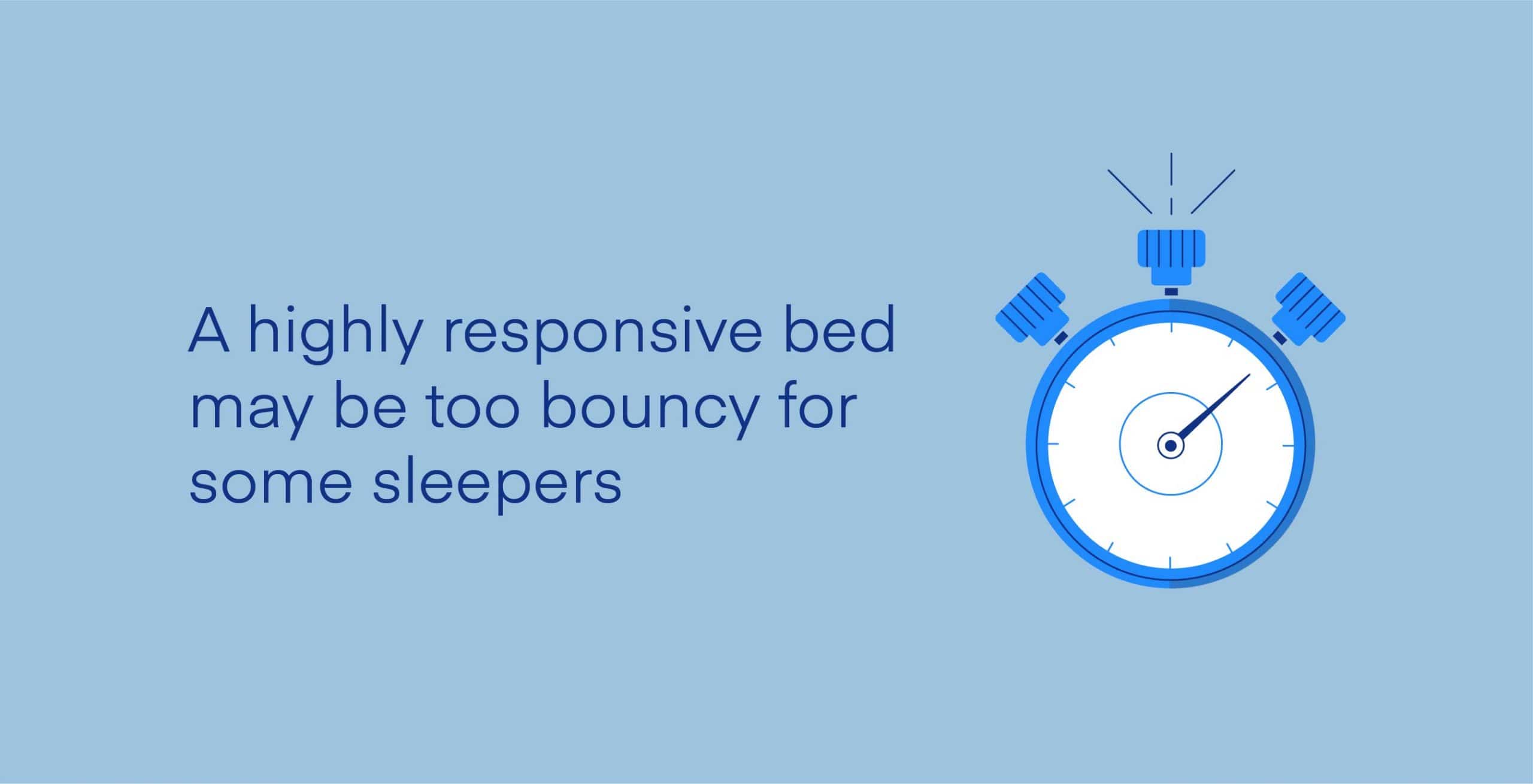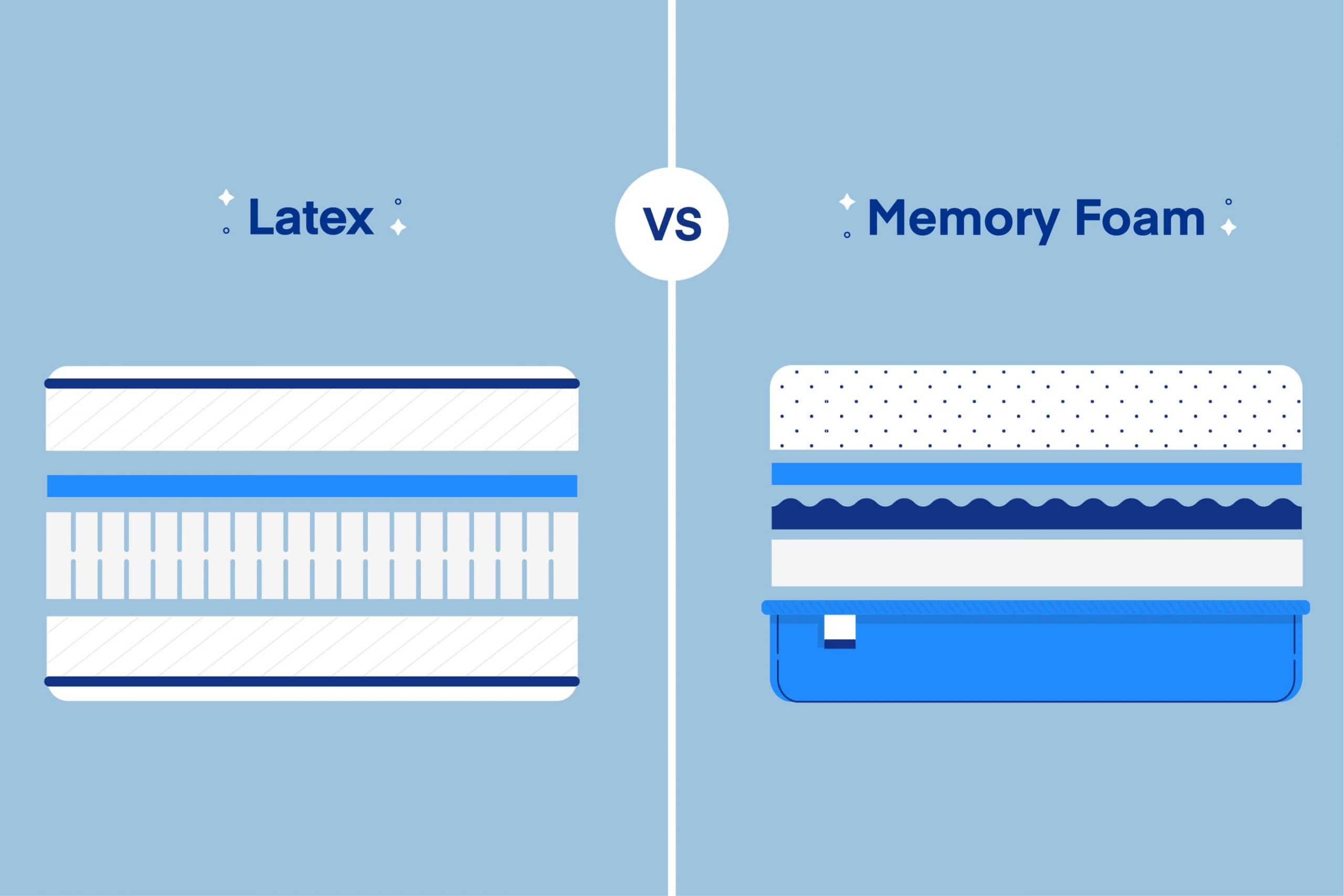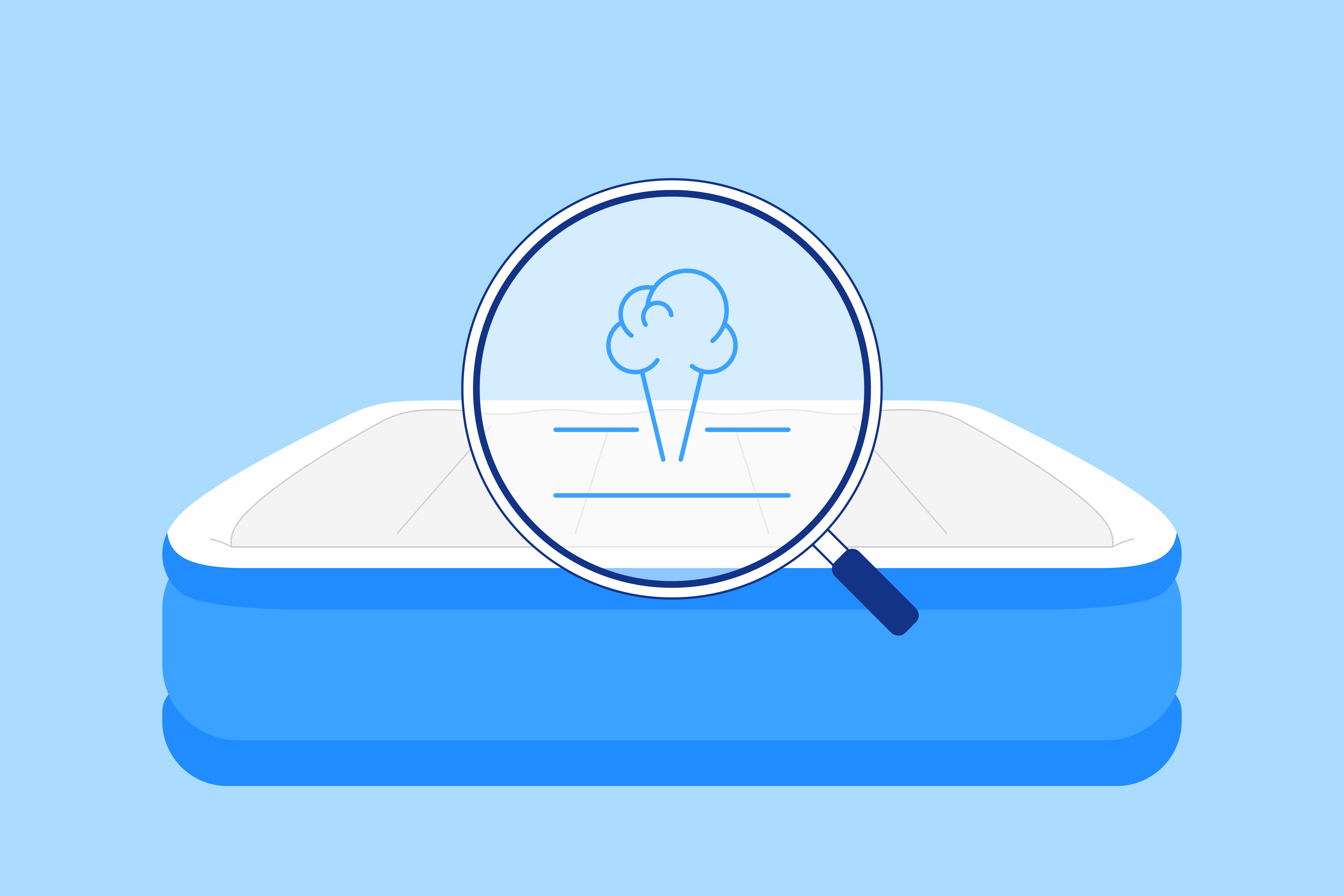Key Takeaways
- Memory Foam Characteristics: Memory foam is a type of foam made from polyurethane and has viscoelastic properties. It conforms to the body’s shape in response to heat and pressure, providing excellent pressure relief. Memory foam mattresses are often infused with materials like copper, graphite, or gel to enhance breathability and heat dissipation.
- Latex Foam Characteristics: Natural latex is derived from rubber tree sap and processed into one of two types of foam. Synthetic latex is derived from petrochemicals and is less durable than natural latex. Latex mattresses have a different feel compared to memory foam, offering a more buoyant and lifting sensation. They are naturally cooling and may be a good choice for those who tend to sleep hot.
- Choosing Between Memory Foam and Latex: The right material depends on individual preferences, including sleep position, temperature sensitivity, and budget. Memory foam excels in conformability and motion isolation. Meanwhile, latex offers responsiveness, cooling properties, and supportive buoyancy. Eco-conscious consumers may prefer latex, but they should verify any certifications first.
A mattress that cushions your pain points and supports your spine will keep you comfortable all night long. However, there’s no one mattress that’s perfect for everyone. We all have unique comfort needs along with likes and dislikes. To help you in your search for the perfect night’s rest, we’ve compared memory foam and latex mattresses.
Memory foam has been in the mattress market since the 90s, whereas latex mattresses were introduced in the 1930s. We’ll give you a quick overview of these two mattress types along with their strengths and weaknesses. As you’re reading, start thinking about what specifically you need from your mattress. You never know; your best mattress could be a memory foam or latex model.
What is Memory Foam?
Memory is made from polyurethane foam (poly-foam). The poly-foam goes through a manufacturing process involving chemicals, plant oils, or a combination of both to give the foam viscoelastic properties. The properties are different enough to create a new foam —memory foam. Unlike polyfoam, memory foam stretches, conforms, and molds when exposed to pressure and heat.
A memory foam mattress adjusts and changes shape according to the heat and pressure of the sleeper’s body. The foam stretches and gives under the high-pressure points of the shoulders and hips. If the sleeper changes position, the memory foam gradually returns to its original shape while the foam underneath the sleeper conforms to their shape. If the sleeper stays in one position, the memory foam continues to deepen the pressure relief.
Memory foams are made in different densities. They can also be made in firmnesses that range from soft to firm. Softer memory foams make up the comfort and transition layers of the mattress, while the firmer foams are used in the support core.
Manufacturers also work to improve the breathability of their memory foam. There are formulas and manufacturing processes that enhance the open-cell structure of each foam cell to promote airflow without compromising the durability of the foam. To further dissipate heat, memory foams are often infused or swirled with copper, graphite, and gel. These extra materials help absorb and move heat away from the sleeper’s body.
Memory foam mattresses work well for many types of sleepers. The high conformability and contouring of a memory foam mattress makes them a popular choice for side sleepers. The memory foam helps maintain a neutral spine by relieving pressure at the hips and shoulders. At the same time, the mattress conforms at the head, waist, and knees.
Memory foam also provides excellent pressure relief and support for back sleepers as the foam cradles the lower back. A soft memory foam mattress can be problematic for side sleepers because their hips will sink down too far, putting pressure on the lower back. However, there firm memory foam mattresses that contour to the body while preventing painful sinkage for stomach sleepers.
What is Latex Foam?
Latex mattresses can be made with natural or synthetic layers. In some cases, latex foams are actually a mix of natural and synthetic latex.
Natural latex is derived from the sap of the rubber tree, while synthetic latex is man-made. Natural latex goes through one of two manufacturing processes —Talalay or Dunlop— to make the latex foam used in a mattress. Dunlop latex has a denser, firmer feel. Consequently, it’s often used in the transition layers and support core of the mattress. However, there are mattresses with Dunlop top layers. They’re slightly less responsive to movement than a layer of Talalay latex.
Talalay latex goes through an aeration process during manufacturing that makes it lighter and springier than Dunlop latex. Its bouncier feel makes it ideal for comfort layers. However, because it’s less dense than Dunlop, it’s not as durable and isn’t usually used in the support core.
Synthetic latex is derived from petrochemicals. It can feel similar to natural latex and costs less to produce. However, it breaks down faster than natural latex. It’s also not the best material if you’re looking for a mattress without memory foam, as it has a similar production process.
Latex mattresses are often compared to memory foam because they both contain foam layers, but these materials have very different feels. Memory foam is more cradling while latex has a lifting feel. Latex is also naturally cooling, while memory foam mattresses can sometimes retain heat.
Amerisleep Memory Foam and Latex Mattresses
Quick Guide: A 30-Second Summary
| Best Memory Foam Mattress Overall | Amerisleep AS3 |
| Best Latex Mattress Overall | Amerisleep Organica |
-
Price Range
$1149 to $2398
-
Mattress Type
Memory Foam
-
Firmness
5 to 6 out of 10 (Medium)
-
Availability
All sizes
-
Warranty
20 Years
-
Thickness
12 Inches
While we offer five memory foam mattresses our AS3 model is easily the most versatile, suiting back, side, and combination sleepers. Because it has a balanced medium feel, it’s also excellent for couples who are seeking a mattress to share.
- Plant-based memory foam is responsive and cooling
- Five zones of targeted support ease pressure build-up
- Sturdy and supportive poly-foam core for structure
- Most sleeping styles and body types
- Hot sleepers
- Couples
The AS3 is the most popular memory foam mattress here at Amerisleep. This medium mattress is known for its breathability, balance of support and cushioning, and durability. We recommend the AS3 for side and combination sleepers, some back sleepers, and couples.
Inside the AS3 is:
- 2 inches of Bio-Pur® memory foam
- 2 inches of Affinity foam with HIVE® technology
- 8 inches of Bio-Core® foam
Every foam layer is CertiPUR-US®certified, meaning they are free of potentially harmful materials. The mattress’s cover is made from a breathable knit fabric.
Bio-Pur® is a plant-based memory foam made from castor oil. Unlike traditional memory foam, plant-based memory foam is more durable and breathable. Not only that, but Bio-Pur® is springier than standard memory foam, so you’ll be able to move easily in bed.
The Affinity foam inside the AS3 features a zoned technology called HIVE®. It’s divided into five ergonomic zones to evenly distribute your body weight and reduce pressure build-up.
The Bio-Core® base foam is a firm and sturdy material built to last. It supports your spine while also minimizing wear to the mattress.
People who enjoy a buoyant bed can also try the Amerisleep AS3 Hybrid. In the AS3 Hybrid, the foam base is replaced by a support core of pocketed coils, where every coil is wrapped to isolate motion and prevent movement from rippling across the mattress.
The AS3, like other Amerisleep mattresses, come with a 100-night sleep trial, a 20-year warranty, and free shipping and returns.
Quick Summary:
- Balanced for side and combo sleepers
- Zoned technology soothes pressure point pain
- Cooling memory foam is durable and responsive
-
Price Range
$1199 to $2698
-
Mattress Type
Latex Hybrid
-
Firmness
5 to 6 of 10 (Medium)
-
Availability
All sizes
-
Warranty
20 Years
-
Thickness
13 Inches
Our Amerisleep Organica is a natural latex hybrid mattress with a medium feel that can support the body in most positions. The latex, cotton, and wool top is excellent for sleepers who are sensitive to synthetic materials and want to sleep well.
- Natural wool and cotton for a cooling bed surface
- Talalay latex for cushion and comfort
- Pocketed coils prevent motions from spreading across the mattress surface
- Side, back, and combination sleepers
- Couples
- Hot sleepers
- Allergy sufferers
The Amerisleep Organica is a hybrid bed with two types of natural latex. It’s our most sustainable mattress option, as it contains GOTS organic certified cotton and has a variety of sustainability certifications. The Organica’s certifications include:
The Organica is 13 inches thick and has a medium feel so practically anyone can enjoy this eco-friendly bed. Inside the mattress is:
- 1 inch of New Zealand Joma Wool®
- 3 inches of Talalay latex
- 8 inches of pocketed coils
- 1 inch of Dunlop latex
The Organica’s cover is made from organic cotton with hand-tufted rosettes for maximum durability.
Wool acts as both a thermo-regulator and flame barrier inside the Organica. This means it controls the bed’s temperature so you don’t get too cold or hot.
The thick layer of Talalay latex provides ample cushioning for your body without feeling unsupportive. Latex is unique since it’s buoyant and keeps your body lifted rather than causing you to sink into your bed.
The coils we use within the Organica are wrapped in a thin fabric wrapping to minimize motion transfer, coil breakage, and noise. On either side of the bed there are firmer, reinforced coils. This prevents the edges from sagging so you don’t accidentally roll out of bed while sleeping! The Dunlop base foam adds an extra layer of protection and helps your mattress last longer.
Quick Summary:
- Wool cushions your body while keeping you cool
- Talalay latex is soft and cushiony, while the Dunlop latex is firm and durable
- Reinforced coils promote long-lasting edge protection
Memory Foam vs. Latex: Strengths and Weaknesses
Every mattress has its strengths and weaknesses that determine who will enjoy them. What feels comfortable to you will depend on your preferred sleep position, weight, temperature preferences, and other individual likes and dislikes. To narrow down your choices, think about what mattress characteristics are most important to you.
Memory Foam Mattress Strengths
Conformability and Contouring
It’s hard to beat memory foam when it comes to conformability and contouring, which is one of the main reasons why they’re some of the best mattresses for back pain relief. Memory foam naturally stretches and molds to the shape of the sleeper, providing customized pressure relief. The longer you lay on it, the more it forms to your body. It’s slower to respond to movement than other foams, but it changes shape to support the body no matter the sleep position.
Motion Isolation
Memory foam absorbs motion, so it doesn’t transfer across the mattress. Couples will find that they don’t feel their partner’s movements nearly as much on a memory foam mattress in comparison to a model with coils. That means more sleep for everyone.
Sound Absorption
Memory foam is also a natural sound absorber. It also absorbs ambient sound from the bedroom for a quieter night’s sleep.
Hypoallergenic
Dust, dust mites, and other allergens often congregate in mattresses. Memory foam mattresses naturally resist these common allergens.
Memory Foam Mattress Weaknesses
Temperature Regulation
Memory foam can trap heat and overheat the sleeper unless it’s made with cooling technology; and today’s memory foams have impressive designs and infusions to dissipate heat. Memory foams with advanced open-cell structures and gel, copper, or graphite infusions create ways for heat to move away from the sleeper. In short, you’re far less likely to overheat in a memory foam mattress today than you were in the 90s.
Responsiveness
Memory foam slowly returns to its original shape, making it less responsive to movement than some other mattress types. Some memory foam formulas create more responsive foams than others, so responsiveness can vary from manufacturer to manufacturer. There are also manufacturers who use more responsive layers beneath their memory foam layers to prevent sleepers from feeling trapped in the conformability of the memory foam.
Edge Support
Memory foam naturally conforms to the body even when you’re sitting on the edge of the bed. That can lead to the premature breakdown at the bed’s edge. However, some manufacturers counter this problem with denser foam at the edges.
Latex Hybrid Mattress Strengths
Responsiveness
Latex gives you the feeling of sleeping on rather than sinking into the mattress. Latex, while contouring, is a more responsive material than memory foam, so these beds are usually bouncier. Some report latex beds feeling firmer than memory foam beds due to the fact that they aren’t as cradling.
Contouring
Latex foam does an excellent job of relieving pressure. However, it favors contouring to the curves of the body rather than a deep conforming like memory foam. For some sleepers, that’s perfect. If you don’t necessarily want to sink into the mattress, a latex with still relieve pressure.
Temperature Regulation
Latex is naturally cooling, and its cooling abilities are usually enhanced by creating aerated channels throughout the foam. If you’re looking for a cooling mattress for hot sleepers, latex is likely better than memory foam.
Support
Latex mattresses with layers containing zoned support technologies can adapt to the varying pressure needs of the body without causing aches and pains.
Eco-friendly . . . But Not Always
Latex beds can be incredibly eco-friendly. However, this is a strength you have to be wary of because not all latex mattresses are eco-friendly and it can be hard to tell when they’re not. To know the difference, you need to know what you’re looking for.
Latex that’s been certified by the eco-INSTITUT and/or Global Organic Latex Standard (GOLS) tells you the latex is both natural and organic, which may also make it eco-friendly. You can also look for the GREENGUARD Gold and Global Organic Textile Standard (GOTS) to check on the overall eco-friendly and organic standing of the mattress. If the mattress has other independent certifications, a quick online search can tell you if they certify the safety or eco-friendliness of the mattress.
Mattresses made with synthetic latex or that claim eco-friendly, organic, or green standing but don’t have any independent certifications may not be as eco-friendly as you think.
Latex Mattress Weaknesses
Responsiveness

Responsiveness can be a strength, but it can also be a weakness. A highly responsive bed may be too bouncy for some sleepers, especially if you share your bed with a partner. Latex foam does absorb motion and sound, but it will transfer more motion than a memory foam mattress.
Conformability
Latex contours to the body, but it doesn’t provide the snug feeling of memory foam. The conformability of latex is sometimes enhanced by a memory foam layer underneath the latex. However, if you prefer the custom fit of memory foam, a memory foam mattress or memory foam hybrid would probably be a better choice.
Other Types of Mattresses
Hybrid Mattresses
Hybrid mattresses combine the support of innerspring coils with the comfort of foam or latex layers. They typically have a pocketed coil system as the support core, topped with layers of foam or latex for pressure relief and contouring. Hybrid mattresses aim to provide the benefits of multiple materials in one mattress.
See also:
Innerspring Mattresses
Innerspring mattresses have a support core made of metal coils or springs. They offer a bouncy and responsive feel, with good airflow for temperature regulation. Innerspring mattresses come in various firmness levels and are known for their durability and traditional mattress feel.
See also:
Air Mattresses
Air mattresses utilize adjustable air chambers to customize the firmness and support level according to individual preferences. They are often used for camping or as temporary sleep solutions. Air mattresses allow users to adjust the air pressure to their desired comfort level.
See also:
Waterbeds
Waterbeds feature a water-filled chamber as the primary support system. They offer a unique and floating sensation while providing pressure relief. Waterbeds come in various designs, including waveless options, and offer temperature control features for personalized comfort.
Frequently Asked Questions
Which is better memory foam or latex?
Whether memory foam or latex is better depends on your specific needs and preferences. Each material has a different feel, so one may suit your comfort preferences more than the other. Memory foam is also produced from petrochemicals while latex foam is whipped from harvested rubber tree sap. In other words, latex foam can be organic, which is better for the environment.
Memory foam is typically more affordable, which means budget shoppers won’t have to scrimp and save to afford a memory foam mattress. However, while it does cost more, a natural latex mattress has greater durability than a memory foam bed. So you can expect to get more use out of a latex mattress than you would the average memory foam mattress.
What is the difference between memory foam and latex?
Each material has a distinct feel, with memory foam possessing a more cradling feel while latex establishes a more “on top” of the mattress feel. There are also production differences, as latex is made with natural rubber tree sap while memory foam must be at least partly if not wholly synthetic. Memory foam can be eco-friendly, as is the case with plant-based memory foam, but latex is far more sustainable when it comes to production.
The last major difference between memory foam and latex is the material’s affordability. Memory foam is far less expensive to manufacture than latex foam, so a memory foam mattress is more accessible to shoppers.
Is memory foam or latex best for back pain?
Both latex and memory foam can relieve back pain and other types of pain due to their conforming properties. The materials each mold to the body’s curves, cushioning sensitive areas and preventing pressure from building up into pain.
Some sleepers find memory foam feels more conforming, and therefore the better choice for back pain. However, each one is capable of relieving pain in most sleepers, so neither is necessarily a bad choice.
Is latex firmer than memory foam?
Some sleepers consider latex naturally firmer than memory foam because of its buoyant feel. Generally speaking, latex doesn’t conform quite as close as memory foam. However, memory foam and latex mattresses are available in options that span the firmness range, ensuring there’s a mattress suitable for everyone.
Is latex healthy to sleep on?
Yes, latex is perfectly safe to sleep on during the night. There are even certifications, such as GOLS and eco-INSTITUT, that can attest to a latex’s quality and safe production.
Latex may even be safer than memory foam for sleepers with an allergy or sensitivity to synthetic materials. However, people with a latex allergy may be better off with another type of mattress.
Memory Foam vs. Latex: The Bottom Line
Both memory foam and latex mattresses can provide a great night’s sleep. The question is, will one of them work for you? Take a good look at how you sleep. Are you a back, side, or stomach sleeper? Do you get hot at night? Do you share your bed with a partner? The answer to these questions can help you make your decision. When comparing these two mattress types, remember:
- Memory foam mattresses conform to every curve of the body, relieving pressure at the shoulders, hips, and lower back. It continues to relieve pressure even after you’ve been lying on it for a long time.
- Couples may sleep better with the motion and sound absorption of memory foam.
- Latex successfully relieve pressure while providing a quick response to movement.
- Latex can be an eco-friendly and/or organic.
A mattress is a highly personal choice. You may need to try a few models in a mattress store to really understand how they feel. Many manufacturers offer sleep trials that let you return a mattress within a certain window of time if you find it’s not comfortable for you. Remember, no matter the type of mattress you choose, the model that’s right for you is the one that leaves you rested and energized for the day.
About the author
McKenzie Hyde is a Certified Sleep Science Coach and a full-time writer specializing in sleep health and the mattress industry. With a Master of Arts degree in literature and writing from Utah State University, McKenzie combines her passion for writing with her in-depth knowledge of sleep science. Her articles cover a wide range of topics, including best sleep practices for students, the consequences of sleep deprivation, and choosing the right mattress for back pain relief. McKenzie's dedication to delivering accurate and informative content makes her a valuable contributor to the field of sleep health.
View all posts







